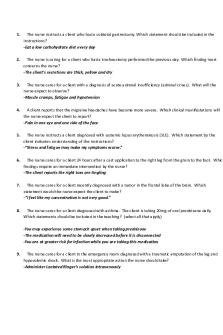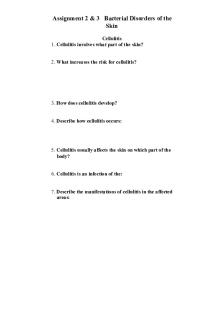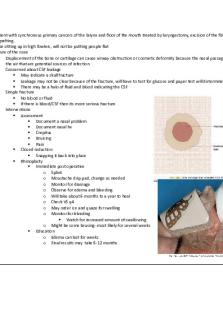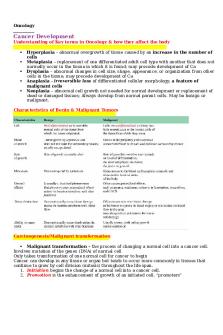Med Surg Biliary 2 clients Case study wk 5 (1) PDF

| Title | Med Surg Biliary 2 clients Case study wk 5 (1) |
|---|---|
| Course | medical surgical |
| Institution | Jersey College Nursing School |
| Pages | 3 |
| File Size | 57.1 KB |
| File Type | |
| Total Downloads | 6 |
| Total Views | 160 |
Summary
case study...
Description
Case Study, Chapter 50, Assessment and Management of Patients With Biliary Disorders 1. Evelyn Bean, 52 years of age, is admitted to the same-day surgery unit for an elective laparoscopic cholecystectomy. The patient presents with jaundice of the skin and sclera. The patient’s urine is dark and the patient stated that she has clay-colored stools. She stated she has occasional colicky pain in her right upper quadrant of her abdomen radiating to her back. The patient had preadmission testing 1 week ago and the results are on the patient’s chart. The record of patient education and an informed written consent are also on the chart. (Learning Objectives 2 and 3) a) What additional procedure will be performed if the common bile duct is obstructed by a gallstone? The client can be subjected to intraoperative cholangiography wherein a stent in the bile duct will be placed and a radiopaque dye will be injected. X-rays will be taken, in order to locate the level of obstruction also if there is a common bile duct obstruction. In extracting stones, the surgeon may prefer to perform an endoscopic retrograde cholangiopancreatography or ERCP and perform basket extraction of the common bile duct stone; or to surgically remove the sphincter of Oddi to allow easy passage of the stones.
b) The nurse in the same day surgery unit provides the discharge instructions to the patient and family before the patient goes for surgery so the patient is fully awake to receive the instructions and ask questions. What written and verbal instructions should the nurse provide? The nurse should provide education to client such as not to drive for 3 days post- surgery or until no longer taking pain medicine and are able to step on the brake pedal without hesitation. Problems like nausea and sore throat are common few days following surgery so use lozenges or salt water to clean mouth. Avoid use of alcohol or food containing lots of fat in order to maintain abdominal comfort. After surgery begin to start eating with a liquid diet then changed to normal diet to avoid abdominal discomfort. be sure to take antibiotics as per physician prescribed in the discharge summary. wash the skin around the incision daily by using soap and water in view to reduce infection. Avoid straining exercises few days following surgery. Incase bleeding occurs incision site patient must report to the hospital immediately Watch for the other symptoms like fatigue, pain around the incision site, diarrhea or constipation, loss of appetite, fever, pus from the incision site, edema and redness on the surgical area.
2. Joe Harrison, a 62-year-old bank executive, presents to the emergency room with severe abdominal pain. He describes the pain as excruciating, and indicates it is located in the mid epigastrium with radiation into his back. The patient states he has not eaten anything in the past 24 hours, but 2 days ago attended a wedding dinner and consumed a large meal and about 4 to 5 alcoholic beverages. Mr. Harrison admits to being a “social drinker,” ingesting 2 to 3 alcoholic beverages several days a week. Based on his clinical presentation and history, Mr. Harrison is admitted with a diagnosis of ruleout pancreatitis. (Learning Objectives 4 and 5)
a)Blood and urine samples are sent to the lab, and the results indicate that the serum amylase and lipase are markedly elevated. How do these findings correlate to the diagnosis of acute pancreatitis? Pancreatitis is a medical condition wherein the pancreas of the patient is inflamed. This results in rupture of the gland and its cells. Pancreas is responsible for producing 2 digestive enzymes lipase and amylase. Inflammation of the pancreas also known as pancreatitis, normally causes high levels of amylase and lipase in the bloodstream, its used as a confirmatory test for acute pancreatitis. If pancreas is damaged, digestive enzymes can be found in blood at higher levels than normal. Amylase levels more than four times the normal levels, or greater than 450 U/L, and the lipase levels greater than400 U/L, are likely to mean there's damage to your pancreas or pancreatitis
b)The nurse notes that Mr. Harrison’s stool is pale and bulky, while his urine is a dark tea color. Correlate these findings to the pathophysiology of acute pancreatitis. one of the causes of pancreatitis could be obstruction in the gall bladder, due to gall stones, bile salts is the reason why stool is colored brown and any abnormality in the levels of bile salts in the it can alter its color. Acute pancreatitis is usually caused by gallstone getting stuck in bile duct on its way from gallbladder into small intestine. Since bile duct shares same opening with pancreatic duct, sudden obstruction of pancreatic opening will cause pancreatic juices to back up into pancreas leading to auto digestion along with inflammation of pancreas.
c)Mr. Harrison’s WBC is 18,500, and his serum glucose is 325. His LDH is 300 IU/L and the AST is 120 U/mL. Based on the Criteria for Predicting the Severity of Pancreatitis, what is Mr. Harrison’s mortality risk? 50% mortality rate for Mr. Harrison. The Ranson’s criteria assess based on age in years > 55 years, white blood cell count > 16000 /mcL,blood glucose > 11 mmol/L (>200 mg/dL), serumAST > 250 IU/L,serum LDH > 350
IU/each has one point and from patient data Mr. Harrison has 5 pointsthe method for finding mortality is based on Number of criteria and this correlate to approximate mortality (%):if·1.0 to 2 = 0%·2.3 to 4 = 15%·3.5 to 6 = 50%·4.>6 = 100%, 5 points correlate to 50% mortality.
d)Mr. Harrison develops hypocalcemia secondary to the acute pancreatitis. What nursing interventions should the nurse implement related to this complication? In this case the nurse would provide a safe environment for the client, due to fracture that may occur secondary to fall. vitamin D supplementation is warranted, along with calcium administration diluted in D5W as Vitamin D and Calcium go hand in hand. ECG to check for long QT syndrome, magnesium administration as well....
Similar Free PDFs

Med surg 1 case study renal
- 3 Pages

Med Surg 2 Final Study Guide
- 25 Pages

Kaplan med surg 2
- 8 Pages

Med SURG; assignment 2
- 9 Pages

Med Surg II - Exam 2 Study Guide
- 57 Pages

Med Surg 2 Case Study #6 Chap 47
- 4 Pages

Med Surg 2 Exam 3 Study Guide
- 22 Pages

Med-Surg Test #2 Study Guide
- 10 Pages

Med Surg 2 Study Guide Answer Key
- 145 Pages

MED SURG 2 first study guide
- 20 Pages

Med surg 1
- 33 Pages

Med surg exam 1 study guide
- 25 Pages

Med Surg Study guide Notes
- 66 Pages
Popular Institutions
- Tinajero National High School - Annex
- Politeknik Caltex Riau
- Yokohama City University
- SGT University
- University of Al-Qadisiyah
- Divine Word College of Vigan
- Techniek College Rotterdam
- Universidade de Santiago
- Universiti Teknologi MARA Cawangan Johor Kampus Pasir Gudang
- Poltekkes Kemenkes Yogyakarta
- Baguio City National High School
- Colegio san marcos
- preparatoria uno
- Centro de Bachillerato Tecnológico Industrial y de Servicios No. 107
- Dalian Maritime University
- Quang Trung Secondary School
- Colegio Tecnológico en Informática
- Corporación Regional de Educación Superior
- Grupo CEDVA
- Dar Al Uloom University
- Centro de Estudios Preuniversitarios de la Universidad Nacional de Ingeniería
- 上智大学
- Aakash International School, Nuna Majara
- San Felipe Neri Catholic School
- Kang Chiao International School - New Taipei City
- Misamis Occidental National High School
- Institución Educativa Escuela Normal Juan Ladrilleros
- Kolehiyo ng Pantukan
- Batanes State College
- Instituto Continental
- Sekolah Menengah Kejuruan Kesehatan Kaltara (Tarakan)
- Colegio de La Inmaculada Concepcion - Cebu


